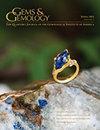珍珠的实时微射线照相:探测器之间的比较
IF 1.6
3区 地球科学
Q2 MINERALOGY
引用次数: 2
摘要
研究人员一直在使用基于胶片的微射线照相技术来揭示天然珍珠与人工养殖珍珠之间的细微结构,有时还使用劳厄衍射和内窥镜检查等其他方法(例如,加利布尔和里齐格,1927;安德森,1932;亚历山大,1941;韦伯斯特,1954;Farn, 1980;Hanni, 1983;波洛和冈蒂埃,1998;Scarratt等人,2000;Sturman, 2009)。今天,实时x射线显微放射照相(RTX)是开展这项重要工作的最重要的测试方法。它还可以与更耗时的x射线计算机微断层摄影术配对,用于具有挑战性的识别和研究目的(Karampelas et al., 2010;Krzemnicki et al., 2010)。采用基于胶片的微射线照相技术,有时将珍珠直接置于高分辨率胶片盒中,或浸泡在减少散射的液体中(例如硝酸铅溶液或四氯化碳,这两种液体都是有害的)。用薄铅片或薄膜包裹单个珍珠也可以减少x射线散射。无论采用何种技术,暗室和一系列的化学药品都是胶片加工所必需的。大约需要20分钟来选择胶片并将珍珠固定在胶片盒上。同时,曝光量必须以平均大小的样品为前提来确定,要记住,一串珍珠的大小通常是分等级的,球体通过中心的曝光时间要比边缘的曝光时间长。接下来,胶片必须显影、定影和晒干。总而言之,这是一个耗时的过程。在过去的20年里,RTX在医疗领域稳步取代了基于胶片的放射照相,在过去的十年里,大多数宝石学实验室都遵循了这一趋势,部分或完全采用了RTX。这种方法有几个重要的优点。不需要危险液体,并且它可以立即或几乎立即产生结果,这些结果更容易在技术团队或出版物和演示中存储和共享。RTX微放射照相也需要比基于胶片的微放射照相更低的总辐射量,尽管可以使用类似的x射线产生管而不需要减少x射线散射。一些宝石学实验室最初使用带有图像增强器(II)技术的RTX单元,通常与数码相机相关,以获取RTX显微射线照片。最近的单位采用平板探测器(FPD),它可以更大的尺寸和高分辨率。然而,FPD的成本约为25,000美元,比II单元和相机高出约40%。An II是一种真空管装置,通过碘化铯(CsI)闪烁体将穿过样品的不可见x射线转换为可见光。然后,可见光在光电表面转化为电子,并在真空管内发射。发射的电子被电极加速并聚焦,电极充当电子透镜,投射到输出屏幕上,并转换成明亮的可见光,由数码相机捕获(图1,左;Ide et al., 2015)。另一方面,FPD是一种薄的,扁平的固体传感器,通过样品透射的不可见x射线被转换成可见光,也是通过CsI闪烁体。可见光是珍珠的实时微射线照相:探测器之间的比较本文章由计算机程序翻译,如有差异,请以英文原文为准。
Real-Time Microradiography of Pearls: A Comparison Between Detectors
ries have been using film-based microradiography to reveal minute structures that separate natural from cultured pearls, sometimes alongside other methods such as Laue diffraction and endoscopy (e.g., Galibourg and Ryziger, 1927; Anderson, 1932; Alexander, 1941; Webster, 1954; Farn, 1980; Hänni, 1983; Poirot and Gonthier, 1998; Scarratt et al., 2000; Sturman, 2009). Today, real-time X-ray microradiography (RTX) is the foremost testing method for carrying out this vital work. It can also be paired with the more timeconsuming X-ray computed microtomography for challenging identifications and research purposes (Karampelas et al., 2010; Krzemnicki et al., 2010). With film-based microradiography, pearls are sometimes placed in direct contact with a high-resolution film cassette or immersed in a scatter-reducing liquid (e.g., lead nitrate solution or carbon tetrachloride, both of which are hazardous). X-ray scattering may also be reduced by simply surrounding individual pearls with a thin lead sheet or film. Regardless of the technique, a darkroom and a series of chemicals are necessary for film processing. It takes approximately 20 minutes to select the film and secure the pearls to the film cassette. At the same time, the exposure must be determined assuming an average-sized sample and keeping in mind that pearls in a strand are often graduated in size and that spheres require longer exposure times through the centers than the edges. Next, the film must be developed, fixed, and dried. All told, it is a time-consuming process. The last 20 years have seen RTX steadily replace film-based radiography in the medical sector, and over the last decade most gemological laboratories have followed this trend by partially or fully adopting RTX. This method has several important advantages. No hazardous liquids are needed, and it gives immediate or nearly immediate results, which are easier to store and share among a team of technicians or in publications and presentations. RTX microradiography also requires a lower total amount of radiation than filmbased microradiography, though similar X-ray generating tubes may be used without a need to reduce X-ray scattering. Some gemological laboratories initially employed RTX units with image intensifier (II) technology generally associated with digital cameras to acquire RTX microradiographs. More recent units have employed flat panel detectors (FPD), which can be of larger dimension with high resolution. However, FPD costs approximately US$25,000, about 40% more than II units and cameras. An II is a vacuum tube device that converts invisible X-rays transmitted through the sample into visible light by a cesium iodide (CsI) scintillator. The visible light is then converted into electrons at the photoelectric surface and emitted inside the vacuum tube. The emitted electrons are accelerated and focused by electrodes, which act as an electron lens, onto the output screen and converted into bright visible light that is captured by a digital camera (figure 1, left; Ide et al., 2015). On the other hand, an FPD is a thin, flat solid sensor where invisible X-rays transmitted through the sample are converted into visible light, also by a CsI scintillator. The visible light is REAL-TIME MICRORADIOGRAPHY OF PEARLS: A COMPARISON BETWEEN DETECTORS
求助全文
通过发布文献求助,成功后即可免费获取论文全文。
去求助
来源期刊

Gems & Gemology
地学-矿物学
CiteScore
2.90
自引率
19.20%
发文量
10
期刊介绍:
G&G publishes original articles on gem materials and research in gemology and related fields. Manuscript topics include, but are not limited to:
Laboratory or field research;
Comprehensive reviews of important topics in the field;
Synthetics, imitations, and treatments;
Trade issues;
Recent discoveries or developments in gemology and related fields (e.g., new instruments or identification techniques, gem minerals for the collector, and lapidary techniques);
Descriptions of notable gem materials and localities;
Jewelry manufacturing arts, historical jewelry, and museum exhibits.
 求助内容:
求助内容: 应助结果提醒方式:
应助结果提醒方式:


